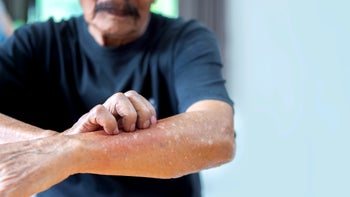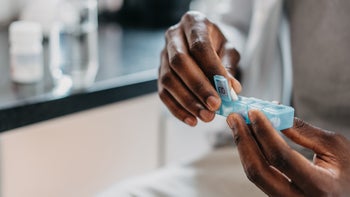
Is Arthritis Hereditary? Yes, But You Can Decrease Your Risk
Key takeaways:
Arthritis is somewhat hereditary because certain genes increase the risk of developing it.
Genes aren’t the whole story. For someone to get arthritis, typically there need to be other risk factors and/or causes.
There’s a lot you can do to decrease your chances of developing arthritis, even if it runs in your family.

Do you have a relative with painful, swollen joints (arthritis)? If the answer is “yes,” it’s normal to wonder what your chances are of developing arthritis later in life. The good news is that having a relative with arthritis doesn’t automatically mean that you’ll get it, too.
So what exactly does “hereditary” mean? Hereditary conditions “run in the family.” In other words, genes (DNA) are inherited (passed down) from your birth parents.
Genes determine everything from what you look like to the diseases you might be at risk of developing. Not everyone who inherits a certain gene will get a disease. But having certain genes can mean the risk of developing a specific disease in the future is higher. This is true when it comes to arthritis.
Search and compare options
Which types of arthritis are hereditary?
All types of arthritis are hereditary in some way. So if someone in your family has arthritis, your chances of getting that type of arthritis someday are higher (but not 100%).
The risk is highest if the family member is a first-degree relative, like a birth parent or sibling. It’s lower for other types of relatives, like cousins, aunts, uncles, and grandparents.
Here are some examples of arthritis that can be hereditary:
Which factors cause arthritis?
It depends on the type of arthritis. Beyond genes, most types of arthritis are triggered by certain factors, including:
Osteoarthritis: This is caused by the wear and tear of aging or injuries. Certain genes increase the risk of developing osteoarthritis, too.
Rheumatoid arthritis: This autoimmune disease is caused by a confused immune system that attacks the joints. Genes definitely play a role here as well.
Gout: This is caused by uric acid crystals that settle in the joints and cause inflammation. Certain genes increase the risk of a high level of uric acid in the blood, which is required to develop these uric acid crystals.
But remember that genes aren’t the only thing that determine whether you get arthritis. Most often, a combination of genetics and environmental factors lead to the end result.
Who is likely to get arthritis?
There are many factors that increase the risk of the different types of arthritis. You can change some of these risk factors (more on this below), but not all of them.
Here are some risk factors you can’t change:
Age: With age, everyone is more likely to develop arthritis due to wear and tear on the joints over time.
Sex at birth: People born with female anatomy are more likely to develop certain types of arthritis (like osteoarthritis and rheumatoid arthritis). On the other hand, people born with male anatomy are more likely to develop gout. But arthritis of any kind can develop regardless of sex.
Genes: As mentioned, genes increase the risk of developing just about any type of arthritis.
Here are risk factors you may be able to change:
Weight: Carrying around extra weight puts more stress on the joints. And this increases the risk of arthritis.
Joint injuries: Arthritis picks on joints that aren’t as healthy as others. So injured joints are more likely to develop arthritis in the future.
Overuse of joints: Certain jobs can put more stress on joints than others due to repetitive movements. This is especially true for jobs that involve manual labor.
Smoking: This increases the risk of developing autoimmune arthritis (like rheumatoid arthritis). And this risk rises if you’ve inherited riskier genes.
Infections: Certain infections can cause arthritis itself, or trigger autoimmune arthritis. For example, bacterial infections of the joint cause septic arthritis (a potential emergency).
At what age does arthritis usually start?
It depends. Some people may never develop arthritis. And others may develop arthritis earlier because they have more risk factors. It’s often difficult to predict who will get arthritis and when they may get it. Researchers are working to learn more.
How do you test for arthritis?
If you have painful or swollen joints, talk to your healthcare provider about your symptoms. The first step to feeling better is figuring out what the problem is.
Oftentimes, providers can diagnose arthritis by listening to your symptoms and examining your joints. X-rays — quick and painless pictures of your bones and joints — are also helpful.
If a provider suspects specific types of arthritis, like rheumatoid arthritis or gout, they may recommend blood tests that can provide more clues. They may also recommend joint aspiration. This involves removing fluid from your joint with a needle and looking at the fluid under a microscope.
Can you prevent arthritis?
Yes and no. There’s a lot you can do to decrease the chances of getting it. This is true whether you’re trying to prevent arthritis in general or if arthritis runs in your family. You can’t change your genes, but you can decrease your risk of getting arthritis by:
Of note, the sooner arthritis is diagnosed, the better. That’s because some treatments — like weight loss and exercise — can help prevent arthritis from getting worse.
The bottom line
Arthritis is somewhat hereditary. This means that if you have family members with arthritis, your risk of developing arthritis some day may be higher. But there’s a chance you won’t get arthritis at all. And there are steps you can take to reduce your risk. Together with your healthcare provider, you can find the best ways to keep moving.
Why trust our experts?


References
Evans, P. L., et al. (2019). Gender-specific risk factors for gout: A systematic review of cohort studies. Advances in Rheumatology.
Fernandez-Moreno, M., et al. (2008). Genetics in osteoarthritis. Current Genomics.
Goolsby, M. A. (2018). Why women are at higher risk for getting arthritis. Hospital for Special Surgery.
Gravallese, E. M., et al. (2023). Rheumatoid arthritis – Common origins, divergent mechanisms. The New England Journal of Medicine.
Ishikawa, Y., et al. (2020). The impact of cigarette smoking on risk of rheumatoid arthritis: A narrative review. Cells.
John Hopkins Arthritis Center. (n.d.). Role of body weight in osteoarthritis. John Hopkins Medicine.
John Hopkins Medicine. (n.d.). Joint aspiration.
Major, T. J., et al. (2018). An update on the genetics of hyperuricaemia and gout. Nature Reviews. Rheumatology.
MedlinePlus. (2021). What is a gene?
Thomas, A. C., et al. (2017). Epidemiology of posttraumatic osteoarthritis. Journal of Athletic Training.

























